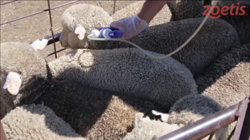Best practice vaccination technique in ewes and lambs
Natalie Roberston, Group Veterinary Operations Manager – Livestock, Zoetis, Sydney

Most vaccines for sheep in Australia are designed to be injected subcutaneously (under the skin). However a recent study, conducted by Dr Tristan Jubb of Bendigo Sheep Vets and supported by Zoetis Australia, has found that even experienced sheep producers and contractors may unintentionally be administering vaccines incorrectly, into muscle tissue. This increases the risk of costly carcase trimming and other side effects such as painful abscesses, loss of condition and even neurological damage or 'staggers' in certain cases.
In the study, humanely euthanised lambs and sheep with various body condition scores and wool cover were vaccinated on the side of the neck with dyed Gudair® — the vaccine used to control Ovine Johne's disease. The impact of quarter and half inch needles, at 45 or 90 degrees to the skin, was investigated.
The results clearly demonstrated that even in the hands of an experienced vaccinator, a half inch needle — used at 45 or 90 degrees to the skin — was likely to deliver the vaccine into the muscles of the neck, rather than under the skin.
In contrast, a quarter inch needle at 45 degrees to the skin was most likely to successfully deliver the vaccine under the skin in lambs and adult sheep in low body condition or with short wool cover — minimising the risk of any adverse reactions.
Even in adult sheep with more significant wool cover, a quarter inch needle, used at 90 degrees to the skin was shown to successfully penetrate through the wool to deliver the vaccine under the skin.
The study also highlighted the importance of correct vaccination site. Vaccinating on the side of the neck, approximately 5cm from the base of the ear, helps to avoid hitting structures including:
- bone
- ear cartilage
- glands in the head or neck region.
It also minimises the risk of injecting into relatively valuable meat cuts.
By vaccinating at the correct site, using the right equipment and approach, sheep producers can maximise vaccine efficacy and minimise the risk of adverse reactions.